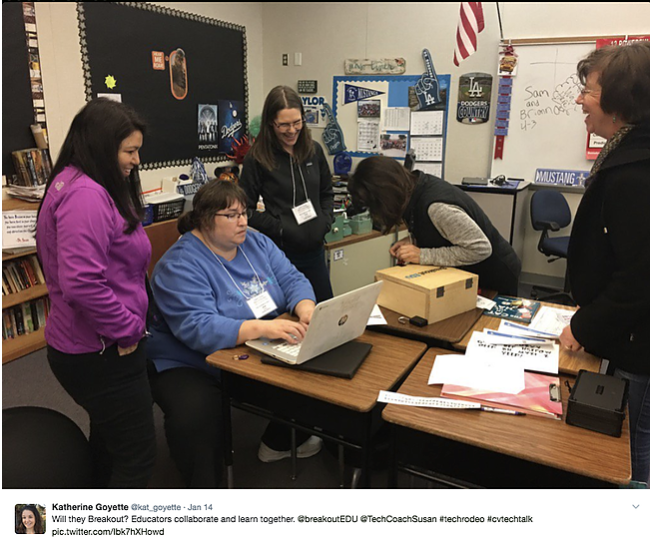
Co-Written with Instructional Technology Specialist Steve Woods
If you’ve gone to a few technology-rich educational conferences, you’ve likely come across one or two BreakoutEdu breakout sessions. Have you had the opportunity to get your hands on one of these uber-tactile and visually rich wooden or plastic boxes, catching the eye with a myriad of locks, helpful tools, primary source documents and mysterious clues? The idea of BreakoutEdu just screams for your students’ attention, providing a unique collaborative opportunity for either small groups or your entire class. BreakoutEDU can even be used to increase collaboration amongst teachers, as pictured below at our last #TechRodeo event.

While it’s undeniable that BreakoutEdu has taken many classrooms across the country by storm, we thought that it would be fun to consider how a classroom (or even an entire campus) could bring the “breakout” game concept “to life” on a larger scale.
Use Your Campus Layout to Your Advantage

Why not begin in your classroom with a virtual “lock” on the front gate of the school grounds? Perform the first activity of the mystery with your class just outside the campus. Once they get it correct, they “open” the virtual lock and proceed to just outside the front office, where they encounter another “lock”, and an activity awaiting them. Maybe the school administrators could participate in this activity by providing clues? Once past the office door, they can proceed to the staff lounge or school library. The idea is to have a feeling of going deeper and deeper into the campus, winding up in the classroom for the final activity. You decide how many levels to this mystery. Could another classroom participate, and use student “actors” to provide clues at one or more level? Could the Librarian, Campus Security Officer or Custodian provide a few clues?
Let Your Students Lead
In true project-based learning style, empower your students to create their own Breakout-type games based on the content they have been learning. Bolster collaboration across grade levels by allowing these students to organize and run the games for younger grade levels on campus. This process creates student leaders, fosters collaborative cultures, and maximizes engagement by students. Maria Montessori and Fred Rogers spoke of the power of children’s play as powerful learning experiences that evoke curiosity and foster lifelong learning. Students who create experiences of play for other children have the opportunity to be imaginative as they connect their learning to relevant games that teach others. As students relay their learning to younger peers, assessment becomes more relevant and meaningful than a grade on a test.
Leverage Campus Features
How about incorporating hands-on learning activities that require your students to determine the volume or area of a particular space on campus? The combined distance of all sidewalks on campus? Or to figure out the genus or phylum of something growing in your school’s garden? The angle of the sun at Noon from a school landmark, while facing an exact direction in degrees? All of these examples are based on the context of real life, and take advantage of the school environment itself.
Collaborate Across Campus & Beyond

Students in this picture researched a historical figure, dressed up as this individual from history, and engaged in conversation with younger students. This is a great start, but what if we gamify the process and expand past the boundaries of the campus? Create a separate and distinct Google Hangout hosted by student “historical actors” in three or more rooms and/or grade levels. Invite classrooms across the country (or just from your school district) to join in the first level Hangout, where they will be provided a variety of ongoing clues by the student actors in the host classroom, a unique ID, and a link to a Google Form to provide their answers. Think you know the answer/ Use the Form to send your ID and answer. The hosting room monitors the corresponding Google Sheet, looking for a correct response. Once a competing classroom provides the proper answer via the Form, the host classroom’s monitor emails an invitation to the competing room’s teacher, providing the next level’s Google Hangout (and a new Google Form link). The above continues until the final, central level, or Hangout is reached. Once a classroom solves the final puzzle, an emailed link is sent, sending the team to a pre-recorded YouTube video where teachers and/or administration and/or students of the host campus congratulate the team for solving the mystery, and invites them to try again next month. Resources Is the BreakoutEDU concept new to you? Visit the official BreakoutEDU website to learn more and purchase a starter kit for your campus or classroom.
